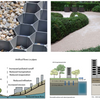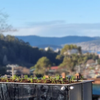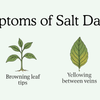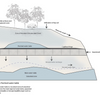Wicking Beds with Gardening Australia
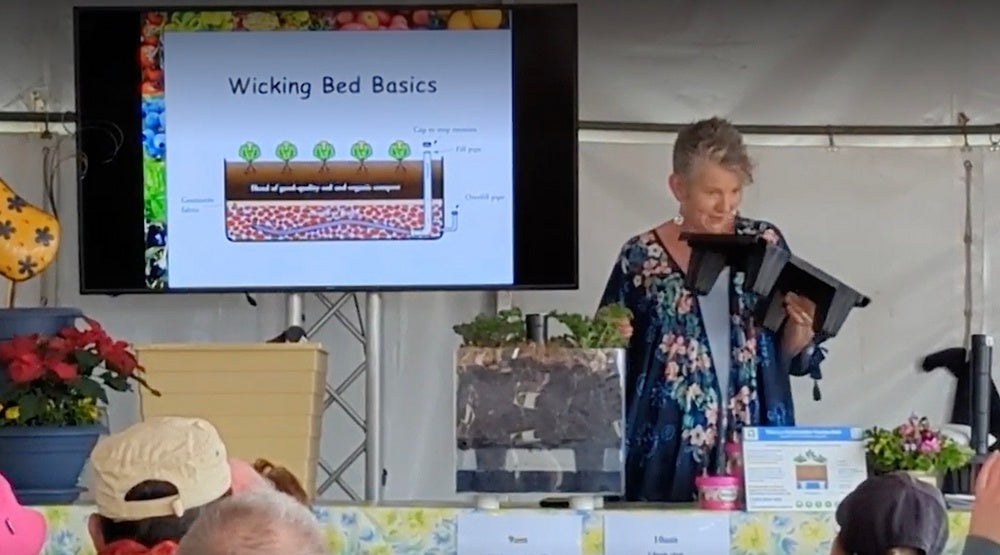
Wicking Beds with Gardening Australia's Sophie Thomson, 2022
Gardening Australia presenter, Sophie Thomson, is a big fan of wicking beds, presenting segments on how to make a wicking garden bed on ABC TV since 2014.
In 2020, Sophie discovered WaterUps through our support of her community gardens project on Kangaroo Island following devastating bush fires.Since then, she has used WaterUps in other gardening projects including at her home.
The following video and transcript below (edited to have headings added) is from her presentation at the Queensland Garden Expo in Nambour in July 2022 on Wicking Beds.
“
Okay, so the one disclaimer I need to put with this talk: they're very addictive. I started with one, I've got 22 (that are one square metre, right), as well as about 80 square meters of in ground veggie garden. And, actually, if I knew about them when I started my veggie garden, probably two thirds of it would be wicking beds, right? They literally make gardening easier. And when you are busy, to take the stress out of things, that is huge. So you can do them either way.
Reservoir Layer
Now really, this is the principle. So we've got soil with, down here I've got soil or gravel. I used to make them using Scoria. Now, that was before these high- tech inserts, (being WaterUps) right? Because I was making them with whatever I can. So basically, all this does is, this becomes a reservoir layer. It's where the water goes. So you've got your reservoir layer, you've got your soil.
Soil
Now, the soil can't be cruddy soil. It's got to be high quality veggie garden soil with high organic matter. Why? It's because wicking only works with high organic matter content and then you have to have some sort of barrier between the soil and the reservoir layer. So when I did them in the old days, I did them Scoria or gravel. Why? Because the Scoria was free. Someone was trying to get rid of it out of their garden. I'm always on the scram for doing things as cheap as you can.
Fabric
Some people said to me, oh, they put shade cloth down in between. Shade cloth let's too many fines of the soil get into the reservoir layer, which is actually going to gung up your reservoir layer. So you lose capacity in your reservoir layer. And so I use geotech fabric. Geo textile fabric is this sort of synthetic, very tightly woven fabric. It's what they put over agricultural grains and it means no fines of the soil go down into the reservoir layer.
Inlet and Overflow Pipes
So basically what happens is you have a way to get water in, an inlay pipe and you have an overflow pipe. Now this was something taken off the Garden Australia website when I did a segment on making them years ago. And it's not quite right. The overflow point needs to actually be at the right height. It needs to be at the join of the soil and the reservoir. So, there are lots of different ways that you can make them. But the principal's the same. This is how I used to make them with Scoria. These are wicking beds. Sorry, these are the WaterUps.
Community Garden on Kangaroo Island
Now, when I was doing the Kangaroo Island (K.I.) community garden. So I came up with this idea that we set up a community garden where we could grow some produce to help support these people that have lost everything. I can't go over there and help them pull down fences, but I can help them grow veggies. And to me, to give them a place where they could get their hands in the soil was what I wanted to do. And at the time, I was having to take everything from the mainland to K.I. So it's about a long half-day trip to get there from my place. And we were having to transport everything to the island. So I had to take the soils over to the islands. I had to take the IBCs over to the island. And then I'm looking to have to Scoria over to the island too, on the ferry.
Grant for Portable Gardens
This is the most expensive ferry in the world per distance, literally. And I was getting no subsidy to get over there. And I came up with this idea that I thought might get us the government grant, which it did. And as part of that was to make this community garden portable. So rapid build and portable. The reason why, rapid build, I only had a window of six days in my calendar between talks that we could do anything. And portable because if it was deemed in a couple of years that you didn't need the community garden at this site. It could all be forked onto a truck and taken to someone's home.
WaterUps makes gardening beds lighter
Now if we're talking about one square meter IBC wicking beds, and you've got 30 centimetres of soil per square, that's 300 kilos of soil, so it's still hard to fork onto a truck. But if I put gravel at the bottom, that's probably another 200 kilos. So suddenly I've got 500 kilos we're trying to move. If I put WaterUps in there, that's almost no weight in the reservoir layer. So I thought, okay, this is going to cost us a lot more to do it with WaterUps, but it means I could fulfill this portable criteria. I was actually pitching for grants from Minderoo Foundation, as well as my state government. So I needed to come up with ideas that they might think, that's a great idea. So we ended up going for WaterUps. And to be honest, I had done one wicking bed in with WaterUps before, but I'd always thought I do everything not on the cheap. I do everything that's affordable, right? Because I'm thinking, well, if you haven't got a lot of money, you still want to grow veggies, how can you grow it that it doesn't cost money?
Long Lasting Garden Beds
So I hadn't necessarily really got into these, but for my community garden build, we got into them. And because I was already doing IBCs, now there's no original idea in gardening. I'd seen someone in Melbourne on Instagram doing IBC wicking beds. And I'd already worked out that my wooden ones, while they were cheap, they would fall apart, and I'd have to remake them in a couple of years. And so I thought, you know what? I want to do something that I don't have to remake. And with a plastic IBC container you are going to have, it'll last you for 20 years. The plumbing fitting is a tank fitting. They're not going to ever deteriorate. So this was something that would have longevity.
Wicking drains can be flushed out
Where I live, I garden with highly salty water, 1700 parts per million. If anyone knows things, around my area, people garden. Well my first water access, where we are was 2,400 parts per million, now I'm down to 1700 parts per million. So what happens is, if I've got a wicking bed, like a closed loop and I keep putting salty water in here, eventually the salts are all going to accumulate in there, aren't they? And I'm not going to be able to get them out. So I saw other diggers, I will always acknowledge where I pinched ideas from. I saw on diggers, where they put the outlet, the overflow, right at the bottom on an elbow. And what that meant is, that you could drain the water out of the reservoir. So in winter, I open mine up so that they drain constantly because winter is my wet period. So my wet period, I let the rain flush all the salts through the system. Does that make sense? And that's how I get away with it.
Having an outlet pipe is essential
Now, about the same time, I've had a number of callers on talk back radio ring up and say, "Sophie, I've got a wicking bed. It's been fantastic. My grandchild was helping me in the garden, and I had a bottle of soluble organic fertilizer sitting on the garden bed. And they thought they would help me, and they emptied the whole bottle into the wicking bed. What can I do?" Well, if you haven't got a way to drain it, you've actually got to dig it out. Because probably, too much of a good thing is not going to be good in that situation.
Using IBCs
So I thought, well, with my IBCs, I quite like the opportunity that I can put the tap right at the bottom and drain them, should I need to. And so, on Kangaroo Island, we set up this rapid build community garden. I took, now, I can't remember. I took 15 IBCs to K Island, back loaded on someone's big quarry truck. And we put six into the community garden that was already existing in Kingscote and we built the other 24 into the community garden over at Parndana. And so these are the workshops (images on screen).If you go to the Garden Australia website, you'll see a segment (Wicking Beds Gardening Australia) where I make a wicking bed out of these IBCs and you will see me using an angle grinder.UNow, unlike Milly, that is not my natural habitat. My husband gave me a five- minute lesson on how to use an angle grinder. And the crew kept saying to me, "Sophie, stop looking so terrified." I'm like, "This is a widow maker." So my husband uses these big things and it was, that's not me. But I have done it. So basically what happens, you cut them in half and you get two beds out of one thing and they last forever.
WaterUps easily adapted to different “tank” sizes
Now, I have had contact with the distributors of these, and these were never set up for IBCs, right? So what happened is I was doing them. And so now we've had to adapt them to fit into the IBCs. And you'll actually see that we've had to cut them because the IBC isn't just a plain square tank, it's got funny little bits out of it. And so we put a raft of these WaterUps in there and I make a bridge in the middle with a bit of core flute, couplets every few years. There's a lot of core flute looking for a recycling opportunity. And you can some of them to good use.
Use WaterUps Joiners or Cable Ties
So bit of core flute. You can get joiners. When we were building the community garden, I had all the joiners over there and we had about 35 people trying to help, it was absolute chaos. It was fantastic, but it was chaos. And the joiners kept flipping off. And in the end, we went, you know what? A cable tie, how simple is that? So we just attach everything with cable ties. So this is my version.
Huge Fan of WaterUps
And so the ideal is that, but I want tell you why I've become a huge fan of them. So I used them on KI because they were portable. And then we came back to my place and I actually made a couple more. And my daughter, who's here with me, she's goes to an agricultural high school, and she had to do this project and mom may have suggested something out of self-interest. And that was, “Why don't you check if there's a difference between using a WaterUps wicking bed and a Scoria wicking bed? Why don't you check if there's a difference in growth?” Now we did it over winter in my poly house, wasn't any difference in growth at all, that I really noticed out of Scoria and this.
Waterholding Capacity of WaterUps is the best
But, I'll tell you what we found. The water holding capacity of a WaterUps wicking bed in my IBC with 144 litres of water in the reservoir versus the Scoria bed of a 66 litres. So, Waterups had more than double the water holding capacity of my old Scoria beds. And when you live somewhere like me, it's a 40 degree week, I might have to top up twice a week with Scoria. But with this, I only had to top up once a week. So when I saw the difference was the water holding capacity and it was easier, it was like, this is the way to go. So I'm totally biased and think these are fantastic.
Use Perlite as Wicking Agent
So basically, as you can see here, this is the water layer. This is the plastic barrier. Then you have to work out how you can wick water from the reservoir up to the soil. And that's where we use perlite. So perlite, if you are doing a lot of wicking beds, hydroponic straws, do big bags of perlite. So when we went to KI, we went over there with big bags of perlite that were quite cheap. The other thing is that with perlite, if you are touching it a lot, it can sort of buff your hands. So we made sure, as a community build, everyone had gloves on. We also put water in the big bags. There's quite a bit of dust, which you wouldn't want to be breathing in. So we put water into the bags to try and wet the perlite. And then you put the perlite in these areas like that. Now, and that's what they've done here. And you can buy these kits. (WaterUps wicking Cells.)
WaterUps in Square Planters
Now, I absolutely love these pots. I think they are fantastic. I'm just going to turn it around so we can see there's a hole, there we are. Okay, so this is already designed for you. Okay, so this is an especially designed wicking bed pot. There are still watering pots, are not a new thing. Who remembers them from, probably the '80s. No, I was in the nursery in the '80s, in the late '80s.
But one of the things that self-watering pots back then, because we weren't being water wise because we hadn't had issues of water security, people tended to water them daily. And so the challenge with that is that the plants actually got wet feet. And a really important thing in soil is air. And so you need to make sure that you are not constantly, people say, I've got wicking beds, but you're topping them up daily. You actually don't want that, right? You want to make sure that there's a cycle of the soil drying out before you top it up. And so these wicking containers are great.
Minimise watering with WaterUps
You can make your own. You can look at Roland's thing on how he made a wicking bed out of the phone boxes. That's on Gardening Australia. You can look at mine. But if you are in a courtyard, or let's say you had a balcony guard, you don't want to be fussing around with stuff up there. Anything you can do to minimise work in a garden means that you've got more time. Minimise boring work like watering things. You've got more time for the fun stuff. So 0erlite simply goes in there. In the old days, I remember when WaterUps first came out, they were actually putting soil in there, but actually perlite works better to draw up.
My process
Now I do something in my big ones that's slightly different. I do use geotextile fabric, just to stop because otherwise you can see that it's not quite a perfect fit. Can you see that? So soil's going to go down in there and gunk it up. So we do use perlite. And then you fill it with good soil. Now can I tell you, never skimp on soil to grow veggies. The quality of your crop is determined by the quality of your soil, right? It's really simple and spectacular soil will yield you spectacular crops. It does need to be replenished with organic matter if it's in a pot or a wicking bed, like it would do in the garden. Soil is like a brew. It's like a living organ. Well, it's billions of living organisms actually. But soil is ongoing, and soil improvement is ongoing. Sometimes I meet people who say, "Look, I've done a wicking bed, I've put the soil in, tick." You are going to be putting more compost, more organic fertilizer every time you plant. That's really important.
Don’t let light into the Reservoir Layer
Now, if you are going to do them with the IBCs, which I do, it worries me, if I go back, it worries me. So this lets light through. If you have the reservoir layer, you get light through. So it worries me because I've seen that if you don't cover it with something, the water in there goes green. You get algae growing.. I know algae might be one of our future food crops, but not necessarily in the box bottom of your wicking bed. So I clad them with wood. Now, this is the community garden that we were building. This is the first woman I ever saw. She's in Melbourne where it's cold. She was just using black weed mat to cover the sides. I like things that look pretty. Anyone else like a pretty veggie patch? A veggie patch, to me, just the produce is aesthetically pleasing. I want the whole environment to be aesthetically pleasing. I want it to feel like this is heaven in a veggie patch. And I don't like neat veggie patches necessarily, but I just want a veggie patch that's aesthetically pleasing.
Attractive Wooden Garden Beds
So on KI, this is what we did. We made all those panels back in my shed. Now we transported all the panels over there and put them on the side. And because the IBCs had these metal things, it's really easy. You can actually drill straight off them if you put some battens on. Or we had them as panels to make it quicker, so that we could do it in a hurry. And that does two things. It insulates the side. It does also mean that light's not getting to that reservoir layer, so the water won't go green. So that's really important.
”
Thank you Sophie, we are glad you have discovered WaterUps and are a big fan. And we're glad you have been able to introduce to Gardening Australia followers the benefits of wicking beds.




